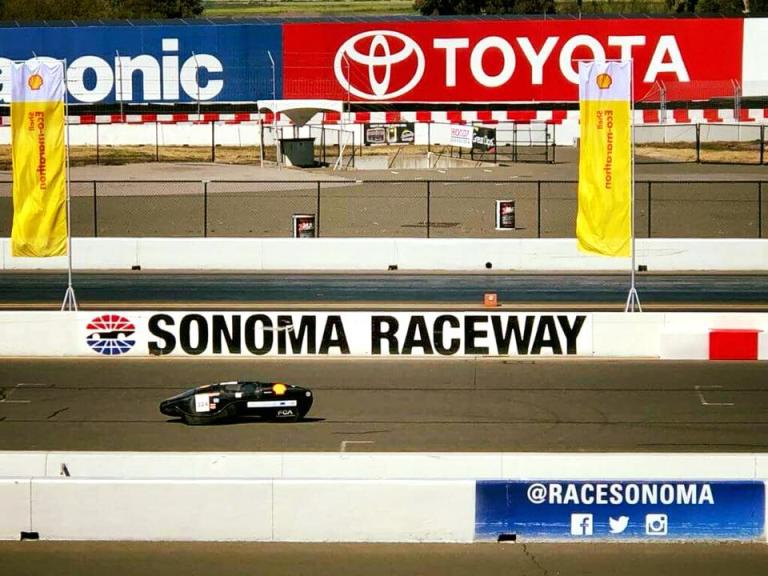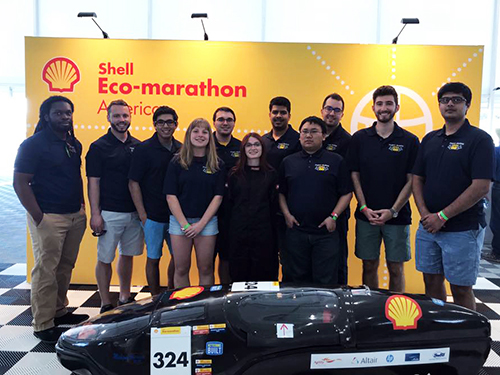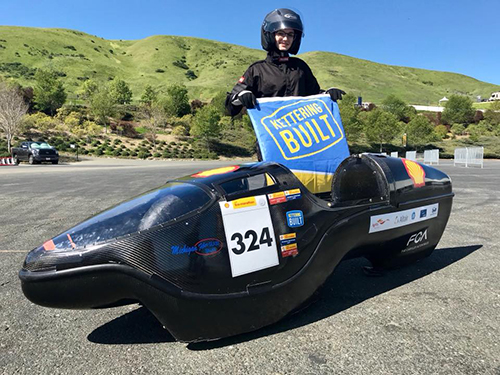
Kettering University’s Shell Eco-marathon team left their second Americas competition with a third place finish, building on their experiences and lessons from their first competition last year.
The Kettering team, Electric Bulldog, was one of 100 teams that participated April 18-22 at Sonoma Raceway in Sonoma, Calif., where the teams either competed under the prototype category or the urban concept category. Electric Bulldog was one of 22 teams to compete with a battery electric powertrain in the prototype category. 
The e-Bulldog achieved 6,370 MPGe (189 mi/kWh), behind only Oregon State University and Duke University.
“We went from 102 mi/kWh our best run last year to 189 this year. I got really excited. It was really good to see to actually see us in a place we thought we should have been in the first place. It just took a little bit of a learning curve to get there,” said Jamie Everhart ‘18, Shell Eco-marathon team leader. “It was a great experience.”
For the battery electric category, the goal of the competition was to build a safe, one-person vehicle designed to maximize energy efficiency. The teams had 24 minutes to complete a 6-mile track. With a joule meter hooked up to the car, they were evaluated on completion time and efficiency.
“From last year to this year we mainly were looking for any improvement to make to see a difference in efficiency. We had a revelation close to the end that made a big difference,” Everhart said. “We nearly doubled our efficiency. That’s what the competition is all about.”
Allan Taylor, lecturer in the Electrical & Computer Engineering Department and faculty advisor for the Shell Eco-marathon team, was thrilled have a third place finish. Taylor and a few team members had to leave early the last day of competition, and he remembers yelling with excitement in the airport.
“I couldn't believe that the slight adjustments we made to the steering and motor control software could have made such a big difference,” Taylor said. “Several other modifications probably made an impact as well, like switching to a different motor and other mechanical adjustments.”
Looking forward, the Shell Eco-marathon team hopes to also compete in the urban concept category, which takes more time and more work, but it’s worth it, Everhart said. The vehicle is bigger, has four wheels, tail lights, windshield wipers and an industry standard electric vehicle communications system. It’s much more representative of an actual electrical vehicle.
“I'm excited to get things going for year three. The urban concept project sounds like it will be a lot of fun, especially since taller people would be able to ride in it or drive it because of the larger and heavier design of the vehicle,” Taylor said. “Having our current prototype around in good working order will also be useful to help promote the team and compare numbers with.”
To make this new vehicle possible, the team wants to recruit more students, whether they are studying electrical engineering, mechanical engineering, industrial engineering, business or any other field. All students are needed, Everhart said.
“To continue the legacy of the program and make it an established program, we really need to build something and get our hands dirty,” he said. “If you want to build an electric vehicle from scratch, come join us. It’s something that’s very interdisciplinary.”
For more information or to join the team, contact Everhart at ever7299@kettering.edu.